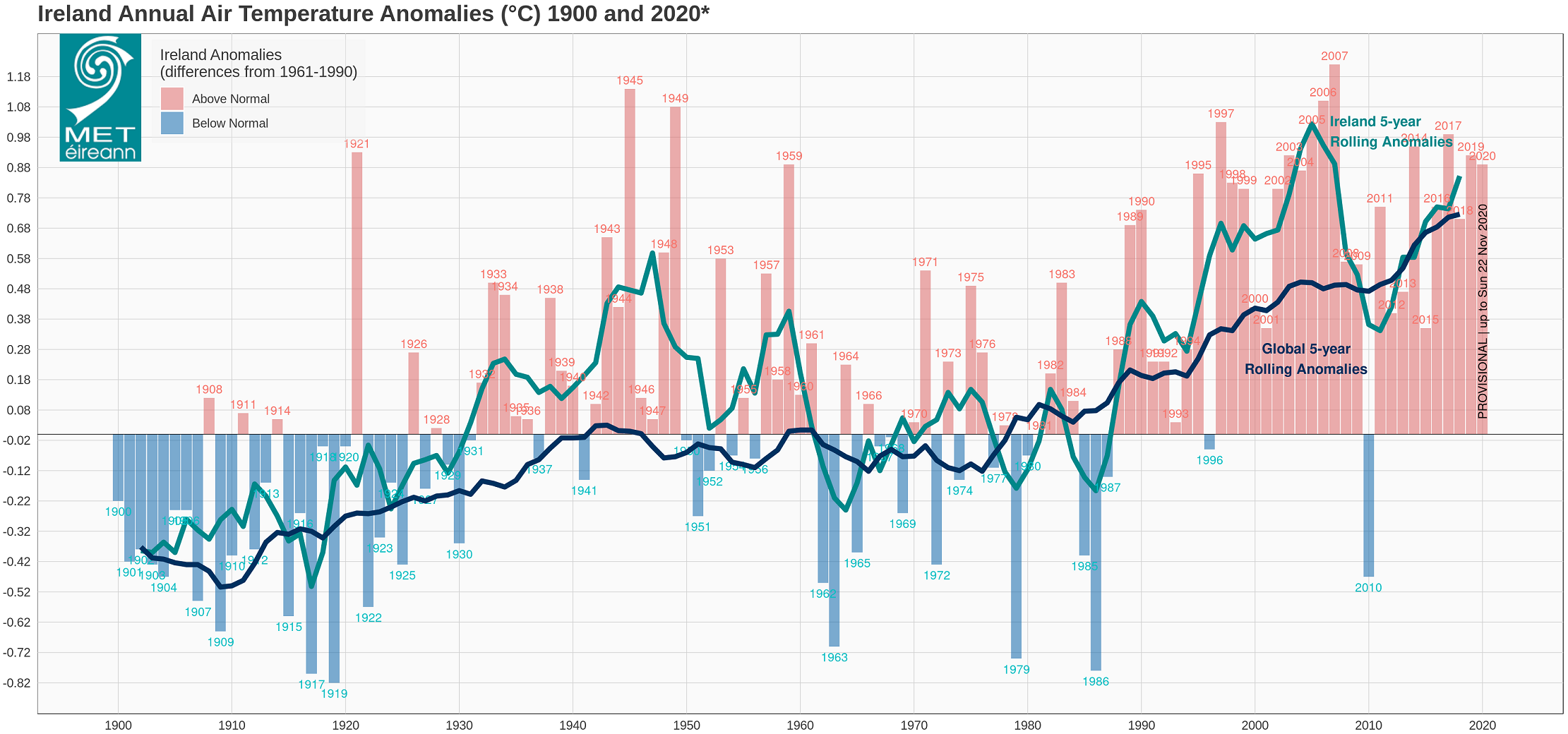- 2020 record-breaking year in Ireland for February rainfall and dry Spring
- Extreme weather patterns experienced in Ireland in 2020 likely to become more common in the future
- World Meteorological Organization (WMO) statement on global climate says 2020 on course to be one of the three warmest years on record worldwide
Today, the WMO published its Provisional Statement on the State of the Global Climate in 2020, on what is the 5th anniversary of the Paris Agreement. It stated that 2020 is on course to be one of the three warmest years on record worldwide. 2011-2020 will be the warmest decade on record.
Ireland’s meteorological data for 2020 also provides further evidence of a warming Ireland. 2020 is on course to be the joint ninth warmest year on record in Ireland.
Met Éireann analysis of 2020 temperature and rainfall data from Ireland provides evidence of the country’s changing climate:
- 2020 is on course to be the 10th consecutive year with an above normal temperature for Ireland
- 2020 data indicates that 19 of the 20 years of this century have had an above normal temperature
- February was the wettest February in over 50 years with 252% of normal rain falling and 16 of Met Éireann’s core network of 25 stations recorded their wettest February on record
Furthermore, Ireland has felt the impacts of climate change this year:
- Parts of the East had their driest Spring on record. Countrywide, only 58% of normal rainfall fell this Spring
- August’s sustained wind (10-minute mean) and gust (3-second mean) records were broken during Storm Ellen
Commenting on the data, Met Éireann Senior Climatologist Keith Lambkin said: “As the WMO publishes its ‘Provisional Statement of the State of the Global Climate 2020’, it’s an opportunity to reflect on how 2020 compares to Ireland’s normal climate. Extreme weather experienced in Ireland in 2020 is likely to become more common into the future. Our analysis shows a wetter Winter and drier Spring than we have been used to. This pattern is in line with predicted climate change-related trends for Ireland. We saw the impact of such weather on our daily lives this year with the high level of flooding in February, particularly in the Shannon catchment. At the other end of the spectrum, a national hosepipe ban was introduced after parts of the East had its driest Spring on record. A number of significant storms during 2020, including Brendan and Ellen, caused the loss of electricity, affecting people and businesses throughout the country.”
Lambkin, part of the team in Met Éireann that predicts and analyses Ireland’s climate, and a member of Ireland’s delegation at the United Nations Framework Convention on Climate Change (UNFCCC) Climate Dialogue this week, added: “The warming we see globally is also observed here in Ireland and it is this warming that increases the risk of more extreme weather events. By providing the latest climate information and projections, Met Éireann and its partners continue to help Irish society to develop plans to adapt to climate change and future extreme weather.”
This news comes as the WMO outline the stark reality of increasing extreme events due to global warming. Their key messages include:
- 2011-2020 will be the warmest decade on record globally
- Despite the COVID-19 lockdown, atmospheric concentrations of greenhouse gases continued to rise globally, committing the planet to further warming for many generations to come
- 2020 saw a record number of hurricanes in the Atlantic
- Wildfires consumed vast areas in Australia, Siberia, the US West Coast and South America, sending plumes of smoke circumnavigating the globe
- Flooding in parts of Africa and South East Asia led to massive population displacement and undermined food security for millions
As records continue to be broken globally, so too are records being broken in Ireland. The science is complex but the message is simple – to reduce the extremes we must reduce the warming.

Ireland Anomalies: Malin Head (Donegal), Birr (Offaly), Phoenix Park (Dublin), Valentia Observatory (Kerry) and Armagh Observatory (data courtesy of UK Met Office) *Provisional Global Temperatures Anomalies: HadCRUT4 Near-Global (Land-Sea), Climatic Research Unit, University of East Anglia | Data analysed on Monday 23 Nov 2020 at 12:13 IST / 12:13 UTC
Featured image courtesy of Showyourstripes.info